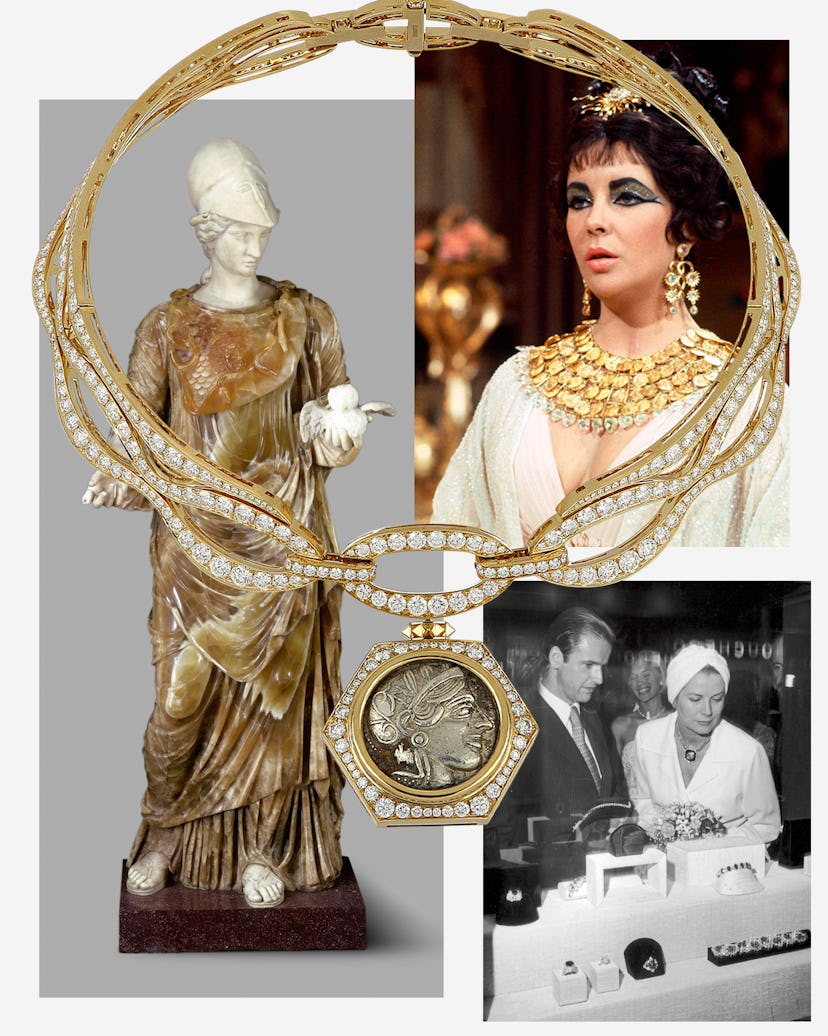Bulgari’s Monete Jewelry Puts History Front and Center
The latest collection featuring rare “coin gems” is a tribute to the Italian jeweler’s 50 years in America.

Some people display their wealth discreetly, while others prefer to wear it around their neck—literally. It’s unclear who the smart money is on. But today, when traditional notions of value and exchange are being challenged by crypto and co., and luxury continues to trade on authenticity and heritage, Bulgari’s Monete collection is flush with cultural currency.
Resuming the tradition of setting coins in jewelry—examples have been found as early as the seventh century BC, as well as in the first, seventh, and 19th centuries AD—the Monete pieces date back to the 1960s, when Rome was the epicenter of glamour, as depicted in such films as Federico Fellini’s La Dolce Vita. The post–World War II period of Il Boom and Hollywood on the Tiber, as cinema-crazed Rome was known, cemented a long-standing relationship between the Italian and American film industries. At the time, paparazzi all but camped outside the Bulgari flagship on Via dei Condotti in hopes of snapping celebrity clients such as Elizabeth Taylor and Grace Kelly. The era witnessed the emergence of many of Bulgari’s most iconic jewels, but the “coin-gems,” as these badges of antiquity are referred to in-house, took pride of place in the company’s epochal advertising imagery. In a memorable campaign that ran from 1965 to 1967, a carpet of Roman coins provides the background for a necklace of amethysts, emeralds, turquoises, and diamonds.
At around that time, Nicola Bulgari, grandson of the company founder, Sotirios Bulgari, experimented with coins set in brooches and chokers before landing on a winning collection of statement necklaces made from long chains. The use of extremely rare coins (among them examples from the ancient Mediterranean world, as well as European pieces from the fifth century BC and American coins from the 20th century) reflected Bulgari’s commitment to honoring history—any irregularities or signs of wear were preserved. Today, Monete includes rings, necklaces, earrings, and bracelets, as well as decorative objects such as boxes, ashtrays, and bowls. A team of specialists is charged with scouring the international numismatics market and sourcing “gems” for these postmodern creations.
The new Monete from the Eden, the Garden of Wonders collection pays homage to the 50th anniversary of the first Bulgari store in the United States. Its star piece is the Goddess necklace (pictured, top), which is set with an ancient silver coin from 449–413 BC on an unmistakably contemporary gold chain adorned with more than 30 diamond carats. The coin bears a bust of Athena on one side and an owl on the other, apparently symbolizing something subtle and ineffable about womanhood. (Many ancient coins featured the faces of female divinities and mythological figures, and their original meanings were often lost once they stopped circulating.) “We offer an ancient coin, a relic of the past, the prospect of a second life,” Nicola Bulgari once said. “Instead of leaving it closed in a drawer, we transform it into a living thing.”
Elizabeth Taylor, who knew a thing or two about sumptuous jewelry—and who was certainly no stranger at Bulgari—once echoed that sentiment. When asked about her acquisitive love of bling, which was often compared to that of her famous screen alter ego, Cleopatra, she replied, “You can’t possess radiance. You can only admire it.”
Courtesy of Bulgari; Silver Screen Collection/Getty Images; BPK Bildagentur/Städel Museum, Frankfurt am Main, Germany, Art Resource, NY; © The Metropolitan Museum of Art, Image source: Art Resource, NY; © RMN-Grand Palais/Art Resource, NY; Roger-Viollet/Jack Nisberg.